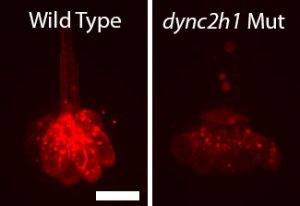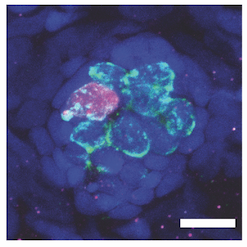Cilia Genes and Hair Cells
I have found that mutations in a number of cilia-related genes lead to resistance to aminoglycoside-induced hair cell death. These genes fall into two major classes, transition zone and intraflagellar transport (IFT) genes. Transition zone proteins are located at the base of the cilia and are believed to regulate which proteins exit and enter the cilia. Mutations in the transition zone genes cc2d2a and mks1 lead to moderate protection against aminoglycoside-induced hair cell death, whereas a mutation in cep290 leads to milder protection. Hair cells in these mutants appear otherwise normal.
IFT proteins are important for trafficking other proteins within the cilia. I have found that mutations in anterograde and retrograde IFT genes lead to strong resistance in aminoglycoside-induced hair cell death. Additionally, these mutants show decreased control hair cell number and a loss of kinocilia. Mutations in most IFT genes I have tested also show significant reductions in the uptake of aminoglycosides and the vital dye FM1-43 into hair cells suggesting a decrease in hair cell mechanotransduction activity. Below is an image of neuromasts from wild type and dync2h1, a retrograde IFT gene, mutant zebrafish exposed to an aminoglycoside conjugated to a red fluorescent dye to see the difference in uptake (Stawicki et al., 2016 and Stawicki et al., 2019). Video of me discussing this work at the 2016 Allied Genetic Conference is available online.

Given the decrease in hair cell number and potential mechanotransduction defects in IFT gene mutants more recent work in the lab has focused on further understanding how hair cells are impacted by IFT gene mutations independent of aminoglycoside-induced toxicity. We have found that hair cells in IFT gene mutants undergo programmed cell death, or apoptosis, as shown below in a neuromast from an ift88 gene mutant where hair cells are labelled in green and cells undergoing apoptosis in magenta. This may be due to mitochondria dysfunction in hair cells in these mutants.

Mutations in cilia genes are known to cause a category of human diseases known as ciliopathies. Similar to the different hair cell phenotypes I see between transition zone and IFT mutants, mutations in these two different classes of cilia genes cause different diseases and symptom profiles in humans. My lab is continuing to how these genes differentially affect hair cells with a particular interest in cell signaling pathways in hopes to better understand how these different phenotypes arise.